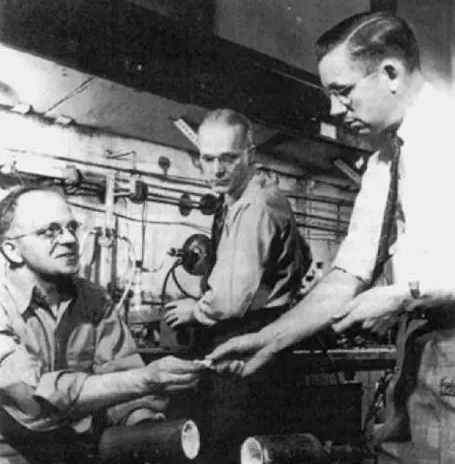PTFE, famously referred to as Teflon, was not a planned exploration. In 1938, DuPont came across this impressive material fairly by mishap, stimulating a transformation in products scientific research and industrial applications.
One morning in 1938, Roy Plunkett, a young chemist, was busy playing with his experiments in a corner of DuPont. His job sounded basic: find a new cooling agent.
(Roy and his colleagues)
Nevertheless, simply when Roy believed it was simply a routine task, things deviated. He saved the tetrafluoroethylene gas in a cylinder and said to himself: “Okay, see you tomorrow.” The following day, when he went back to proceed his experiment, he located that the gas had mysteriously vanished, leaving just a pile of white powder. Well, this was absolutely different from the manuscript he prepared. Picture his expression at that time: half baffled, half curious. Upon further examination, he found that this odd white powder had some amazing superpowers: it was hostile to nearly all chemicals, can stay awesome at severe temperatures, and was as slippery as oil. Instantly, Luo recognized that while he had yet to discover a new refrigerant, he had actually unintentionally discovered the secret active ingredient of the kitchen superhero of the future – non-stick pans. From then on, frying eggs was no more a difficulty, and cleaning pots came to be a wind.
Although the discovery of PTFE was unintentional, it had substantial revolutionary significance for the plastics industry and many other areas, such as aerospace, cars, electronics, and appliances. PTFE is extensively used due to its unique chemical and physical homes – extremely reduced friction coefficient, high-temperature resistance, chemical stability, and non-stickiness. From kitchen utensils to vital parts of the space capsule, PTFE made lots of ingenious applications possible. Yet while PTFE (Teflon ®) noted an advanced innovation in materials science, it was only the start of a long and difficult road to commercialization and widespread application. The first difficulty was not just to discover a new material however likewise to find out exactly how to achieve massive production and exactly how to use it in different areas.
The processes of monomer synthesis and controlled polymerization of PTFE were not totally developed, making it challenging to generate PTFE in huge amounts or a viable manner. While the product’s special properties were beneficial in the long run application, they also posed substantial challenges throughout the production process. Unlike various other typical plastics, PTFE is not soluble in solvents, acids, or bases and does not merge a flowable fluid. Instead, when heated up, it becomes a hard, clear gel that does not thaw and flows like plastics.
(Roy’s Notes: Discovery of PTFE)
To overcome these challenges, scientists and designers battled to find procedures from other fields, such as adapting strategies from metal and ceramic processing. To shape PTFE, a procedure called paste extrusion was made use of, which was obtained from ceramic handling. Although traditional molding and creating techniques had some problem processing PTFE, it was feasible to produce PTFE parts. By 1947, substantial study and experimentation had borne fruit, and a small-scale production facility was established in Arlington, New Jacket. This marked the beginning of Teflon ®’s journey from the lab to the marketplace. In 1950, DuPont opened a brand-new plant in Parkersburg, West Virginia, considerably broadening the industrial manufacturing of Teflon ®. That exact same year, the innovation crossed the Atlantic when Imperial Chemical Industries built the first PTFE plant outside the United States in the UK.
Supplier of PTFE Powder
TRUNNANO is a supplier of 3D Printing Materials with over 12 years experience in nano-building energy conservation and nanotechnology development. It accepts payment via Credit Card, T/T, West Union and Paypal. Trunnano will ship the goods to customers overseas through FedEx, DHL, by air, or by sea. If you want to know more about colors of stamped concrete, please feel free to contact us and send an inquiry.
Inquiry us

